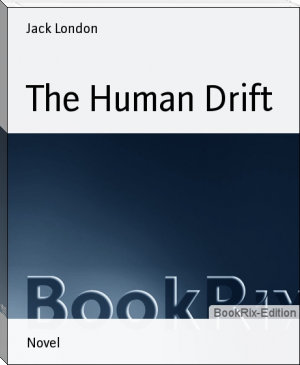The Human Drift, Jack London [good inspirational books .txt] 📗

- Author: Jack London
Book online «The Human Drift, Jack London [good inspirational books .txt] 📗». Author Jack London
The Outlaw's shoes were pulled off, and she was turned out on range.
Finally, the four horses were hooked to the rig--a light Studebaker trap. With two hours and a half of practice, in which the excitement was not abated by several jack-poles and numerous kicking matches, I announced myself as ready for the start. Came the morning, and Prince, who was to have been a wheeler with Maid, showed up with a badly kicked shoulder. He did not exactly show up; we had to find him, for he was unable to walk. His leg swelled and continually swelled during the several days we waited for him. Remained only the Outlaw. In from pasture she came, shoes were nailed on, and she was harnessed into the wheel. Friends and relatives strove to press accident policies on me, but Charmian climbed up alongside, and Nakata got into the rear seat with the typewriter--Nakata, who sailed cabin-boy on the Snark for two years and who had shown himself afraid of nothing, not even of me and my amateur jamborees in experimenting with new modes of locomotion. And we did very nicely, thank you, especially after the first hour or so, during which time the Outlaw had kicked about fifty various times, chiefly to the damage of her own legs and the paintwork, and after she had bitten a couple of hundred times, to the damage of Maid's neck and Charmian's temper. It was hard enough to have her favourite mare in the harness without also enduring the spectacle of its being eaten alive.
Our leaders were joys. King being a polo pony and Milda a rabbit, they rounded curves beautifully and darted ahead like coyotes out of the way of the wheelers. Milda's besetting weakness was a frantic desire not to have the lead-bar strike her hocks. When this happened, one of three things occurred: either she sat down on the lead-bar, kicked it up in the air until she got her back under it, or exploded in a straight-ahead, harness-disrupting jump. Not until she carried the lead-bar clean away and danced a break-down on it and the traces, did she behave decently. Nakata and I made the repairs with good old-fashioned bale-rope, which is stronger than wrought-iron any time, and we went on our way.
In the meantime I was learning--I shall not say to tool a four-in-hand--but just simply to drive four horses. Now it is all right enough to begin with four work-horses pulling a load of several tons. But to begin with four light horses, all running, and a light rig that seems to outrun them--well, when things happen they happen quickly. My weakness was total ignorance. In particular, my fingers lacked training, and I made the mistake of depending on my eyes to handle the reins. This brought me up against a disastrous optical illusion. The bight of the off head-line, being longer and heavier than that of the off wheel-line, hung lower. In a moment requiring quick action, I invariably mistook the two lines. Pulling on what I thought was the wheel-line, in order to straighten the team, I would see the leaders swing abruptly around into a jack-pole. Now for sensations of sheer impotence, nothing can compare with a jack-pole, when the horrified driver beholds his leaders prancing gaily up the road and his wheelers jogging steadily down the road, all at the same time and all harnessed together and to the same rig.
I no longer jack-pole, and I don't mind admitting how I got out of the habit. It was my eyes that enslaved my fingers into ill practices. So I shut my eyes and let the fingers go it alone. To-day my fingers are independent of my eyes and work automatically. I do not see what my fingers do. They just do it. All I see is the satisfactory result.
Still we managed to get over the ground that first day--down sunny Sonoma Valley to the old town of Sonoma, founded by General Vallejo as the remotest outpost on the northern frontier for the purpose of holding back the Gentiles, as the wild Indians of those days were called. Here history was made. Here the last Spanish mission was reared; here the Bear flag was raised; and here Kit Carson, and Fremont, and all our early adventurers came and rested in the days before the days of gold.
We swung on over the low, rolling hills, through miles of dairy farms and chicken ranches where every blessed hen is white, and down the slopes to Petaluma Valley. Here, in 1776, Captain Quiros came up Petaluma Creek from San Pablo Bay in quest of an outlet to Bodega Bay on the coast. And here, later, the Russians, with Alaskan hunters, carried skin boats across from Fort Ross to poach for sea-otters on the Spanish preserve of San Francisco Bay. Here, too, still later, General Vallejo built a fort, which still stands--one of the finest examples of Spanish adobe that remain to us. And here, at the old fort, to bring the chronicle up to date, our horses proceeded to make peculiarly personal history with astonishing success and dispatch. King, our peerless, polo-pony leader, went lame. So hopelessly lame did he go that no expert, then and afterward, could determine whether the lameness was in his frogs, hoofs, legs, shoulders, or head. Maid picked up a nail and began to limp. Milda, figuring the day already sufficiently spent and maniacal with manger-gluttony, began to rabbit-jump. All that held her was the bale- rope. And the Outlaw, game to the last, exceeded all previous exhibitions of skin-removing, paint-marring, and horse-eating.
At Petaluma we rested over while King was returned to the ranch and Prince sent to us. Now Prince had proved himself an excellent wheeler, yet he had to go into the lead and let the Outlaw retain his old place. There is an axiom that a good wheeler is a poor leader. I object to the last adjective. A good wheeler makes an infinitely worse kind of a leader than that. I know . . . now. I ought to know. Since that day I have driven Prince a few hundred miles in the lead. He is neither any better nor any worse than the first mile he ran in the lead; and his worst is even extremely worse than what you are thinking. Not that he is vicious. He is merely a good-natured rogue who shakes hands for sugar, steps on your toes out of sheer excessive friendliness, and just goes on loving you in your harshest moments.
But he won't get out of the way. Also, whenever he is reproved for being in the wrong, he accuses Milda of it and bites the back of her neck. So bad has this become that whenever I yell "Prince!" in a loud voice, Milda immediately rabbit-jumps to the side, straight ahead, or sits down on the lead-bar. All of which is quite disconcerting. Picture it yourself. You are swinging round a sharp, down-grade, mountain curve, at a fast trot. The rock wall is the outside of the curve. The inside of the curve is a precipice. The continuance of the curve is a narrow, unrailed bridge. You hit the curve, throwing the leaders in against the wall and making the polo-horse do the work. All is lovely. The leaders are hugging the wall like nestling doves. But the moment comes in the evolution when the leaders must shoot out ahead. They really must shoot, or else they'll hit the wall and miss the bridge. Also, behind them are the wheelers, and the rig, and you have just eased the brake in order to put sufficient snap into the manoeuvre. If ever team-work is required, now is the time. Milda tries to shoot. She does her best, but Prince, bubbling over with roguishness, lags behind. He knows the trick. Milda is half a length ahead of him. He times it to the fraction of a second. Maid, in the wheel, over-running him, naturally bites him. This disturbs the Outlaw, who has been behaving beautifully, and she immediately reaches across for Maid. Simultaneously, with a fine display of firm conviction that it's all Milda's fault, Prince sinks his teeth into the back of Milda's defenceless neck. The whole thing has occurred in less than a second. Under the surprise and pain of the bite, Milda either jumps ahead to the imminent peril of harness and lead-bar, or smashes into the wall, stops short with the lead-bar over her back, and emits a couple of hysterical kicks. The Outlaw invariably selects this moment to remove paint. And after things are untangled and you have had time to appreciate the close shave, you go up to Prince and reprove him with your choicest vocabulary. And Prince, gazelle-eyed and tender, offers to shake hands with you for sugar. I leave it to any one: a boat would never act that way.
We have some history north of the Bay. Nearly three centuries and a half ago, that doughty pirate and explorer, Sir Francis Drake, combing the Pacific for Spanish galleons, anchored in the bight formed by Point Reyes, on which to-day is one of the richest dairy regions in the world. Here, less than two decades after Drake, Sebastien Carmenon piled up on the rocks with a silk-laden galleon from the Philippines. And in this same bay of Drake, long afterward, the Russian fur-poachers rendezvous'd their bidarkas and stole in through the Golden Gate to the forbidden waters of San Francisco Bay.
Farther up the coast, in Sonoma County, we pilgrimaged to the sites of the Russian settlements. At Bodega Bay, south of what to-day is called Russian River, was their anchorage, while north of the river they built their fort. And much of Fort Ross still stands. Log-bastions, church, and stables hold their own, and so well, with rusty hinges creaking, that we warmed ourselves at the hundred-years-old double fireplace and slept under the hand-hewn roof beams still held together by spikes of hand-wrought iron.
We went to see where history had been made, and we saw scenery as well. One of our stretches in a day's drive was from beautiful Inverness on Tomales Bay, down the Olema Valley to Bolinas Bay, along the eastern shore of that body of water to Willow Camp, and up over the sea-bluffs, around the bastions of Tamalpais, and down to Sausalito. From the head of Bolinas Bay to Willow Camp the drive on the edge of the beach, and actually, for half-mile stretches, in the waters of the bay itself, was a delightful experience. The wonderful part was to come. Very few San Franciscans, much less Californians, know of that drive from Willow Camp, to the south and east, along the poppy-blown cliffs, with the sea thundering in the sheer depths hundreds of feet below and the Golden Gate opening up ahead, disclosing smoky San Francisco on her many hills. Far off, blurred on the breast of the sea, can be seen the Farallones, which Sir Francis Drake passed on a S. W. course in the thick of what he describes as a "stynking fog." Well might he call it that, and a few other names, for it was the fog that robbed him of the glory of discovering San Francisco Bay.
It was on this part
Finally, the four horses were hooked to the rig--a light Studebaker trap. With two hours and a half of practice, in which the excitement was not abated by several jack-poles and numerous kicking matches, I announced myself as ready for the start. Came the morning, and Prince, who was to have been a wheeler with Maid, showed up with a badly kicked shoulder. He did not exactly show up; we had to find him, for he was unable to walk. His leg swelled and continually swelled during the several days we waited for him. Remained only the Outlaw. In from pasture she came, shoes were nailed on, and she was harnessed into the wheel. Friends and relatives strove to press accident policies on me, but Charmian climbed up alongside, and Nakata got into the rear seat with the typewriter--Nakata, who sailed cabin-boy on the Snark for two years and who had shown himself afraid of nothing, not even of me and my amateur jamborees in experimenting with new modes of locomotion. And we did very nicely, thank you, especially after the first hour or so, during which time the Outlaw had kicked about fifty various times, chiefly to the damage of her own legs and the paintwork, and after she had bitten a couple of hundred times, to the damage of Maid's neck and Charmian's temper. It was hard enough to have her favourite mare in the harness without also enduring the spectacle of its being eaten alive.
Our leaders were joys. King being a polo pony and Milda a rabbit, they rounded curves beautifully and darted ahead like coyotes out of the way of the wheelers. Milda's besetting weakness was a frantic desire not to have the lead-bar strike her hocks. When this happened, one of three things occurred: either she sat down on the lead-bar, kicked it up in the air until she got her back under it, or exploded in a straight-ahead, harness-disrupting jump. Not until she carried the lead-bar clean away and danced a break-down on it and the traces, did she behave decently. Nakata and I made the repairs with good old-fashioned bale-rope, which is stronger than wrought-iron any time, and we went on our way.
In the meantime I was learning--I shall not say to tool a four-in-hand--but just simply to drive four horses. Now it is all right enough to begin with four work-horses pulling a load of several tons. But to begin with four light horses, all running, and a light rig that seems to outrun them--well, when things happen they happen quickly. My weakness was total ignorance. In particular, my fingers lacked training, and I made the mistake of depending on my eyes to handle the reins. This brought me up against a disastrous optical illusion. The bight of the off head-line, being longer and heavier than that of the off wheel-line, hung lower. In a moment requiring quick action, I invariably mistook the two lines. Pulling on what I thought was the wheel-line, in order to straighten the team, I would see the leaders swing abruptly around into a jack-pole. Now for sensations of sheer impotence, nothing can compare with a jack-pole, when the horrified driver beholds his leaders prancing gaily up the road and his wheelers jogging steadily down the road, all at the same time and all harnessed together and to the same rig.
I no longer jack-pole, and I don't mind admitting how I got out of the habit. It was my eyes that enslaved my fingers into ill practices. So I shut my eyes and let the fingers go it alone. To-day my fingers are independent of my eyes and work automatically. I do not see what my fingers do. They just do it. All I see is the satisfactory result.
Still we managed to get over the ground that first day--down sunny Sonoma Valley to the old town of Sonoma, founded by General Vallejo as the remotest outpost on the northern frontier for the purpose of holding back the Gentiles, as the wild Indians of those days were called. Here history was made. Here the last Spanish mission was reared; here the Bear flag was raised; and here Kit Carson, and Fremont, and all our early adventurers came and rested in the days before the days of gold.
We swung on over the low, rolling hills, through miles of dairy farms and chicken ranches where every blessed hen is white, and down the slopes to Petaluma Valley. Here, in 1776, Captain Quiros came up Petaluma Creek from San Pablo Bay in quest of an outlet to Bodega Bay on the coast. And here, later, the Russians, with Alaskan hunters, carried skin boats across from Fort Ross to poach for sea-otters on the Spanish preserve of San Francisco Bay. Here, too, still later, General Vallejo built a fort, which still stands--one of the finest examples of Spanish adobe that remain to us. And here, at the old fort, to bring the chronicle up to date, our horses proceeded to make peculiarly personal history with astonishing success and dispatch. King, our peerless, polo-pony leader, went lame. So hopelessly lame did he go that no expert, then and afterward, could determine whether the lameness was in his frogs, hoofs, legs, shoulders, or head. Maid picked up a nail and began to limp. Milda, figuring the day already sufficiently spent and maniacal with manger-gluttony, began to rabbit-jump. All that held her was the bale- rope. And the Outlaw, game to the last, exceeded all previous exhibitions of skin-removing, paint-marring, and horse-eating.
At Petaluma we rested over while King was returned to the ranch and Prince sent to us. Now Prince had proved himself an excellent wheeler, yet he had to go into the lead and let the Outlaw retain his old place. There is an axiom that a good wheeler is a poor leader. I object to the last adjective. A good wheeler makes an infinitely worse kind of a leader than that. I know . . . now. I ought to know. Since that day I have driven Prince a few hundred miles in the lead. He is neither any better nor any worse than the first mile he ran in the lead; and his worst is even extremely worse than what you are thinking. Not that he is vicious. He is merely a good-natured rogue who shakes hands for sugar, steps on your toes out of sheer excessive friendliness, and just goes on loving you in your harshest moments.
But he won't get out of the way. Also, whenever he is reproved for being in the wrong, he accuses Milda of it and bites the back of her neck. So bad has this become that whenever I yell "Prince!" in a loud voice, Milda immediately rabbit-jumps to the side, straight ahead, or sits down on the lead-bar. All of which is quite disconcerting. Picture it yourself. You are swinging round a sharp, down-grade, mountain curve, at a fast trot. The rock wall is the outside of the curve. The inside of the curve is a precipice. The continuance of the curve is a narrow, unrailed bridge. You hit the curve, throwing the leaders in against the wall and making the polo-horse do the work. All is lovely. The leaders are hugging the wall like nestling doves. But the moment comes in the evolution when the leaders must shoot out ahead. They really must shoot, or else they'll hit the wall and miss the bridge. Also, behind them are the wheelers, and the rig, and you have just eased the brake in order to put sufficient snap into the manoeuvre. If ever team-work is required, now is the time. Milda tries to shoot. She does her best, but Prince, bubbling over with roguishness, lags behind. He knows the trick. Milda is half a length ahead of him. He times it to the fraction of a second. Maid, in the wheel, over-running him, naturally bites him. This disturbs the Outlaw, who has been behaving beautifully, and she immediately reaches across for Maid. Simultaneously, with a fine display of firm conviction that it's all Milda's fault, Prince sinks his teeth into the back of Milda's defenceless neck. The whole thing has occurred in less than a second. Under the surprise and pain of the bite, Milda either jumps ahead to the imminent peril of harness and lead-bar, or smashes into the wall, stops short with the lead-bar over her back, and emits a couple of hysterical kicks. The Outlaw invariably selects this moment to remove paint. And after things are untangled and you have had time to appreciate the close shave, you go up to Prince and reprove him with your choicest vocabulary. And Prince, gazelle-eyed and tender, offers to shake hands with you for sugar. I leave it to any one: a boat would never act that way.
We have some history north of the Bay. Nearly three centuries and a half ago, that doughty pirate and explorer, Sir Francis Drake, combing the Pacific for Spanish galleons, anchored in the bight formed by Point Reyes, on which to-day is one of the richest dairy regions in the world. Here, less than two decades after Drake, Sebastien Carmenon piled up on the rocks with a silk-laden galleon from the Philippines. And in this same bay of Drake, long afterward, the Russian fur-poachers rendezvous'd their bidarkas and stole in through the Golden Gate to the forbidden waters of San Francisco Bay.
Farther up the coast, in Sonoma County, we pilgrimaged to the sites of the Russian settlements. At Bodega Bay, south of what to-day is called Russian River, was their anchorage, while north of the river they built their fort. And much of Fort Ross still stands. Log-bastions, church, and stables hold their own, and so well, with rusty hinges creaking, that we warmed ourselves at the hundred-years-old double fireplace and slept under the hand-hewn roof beams still held together by spikes of hand-wrought iron.
We went to see where history had been made, and we saw scenery as well. One of our stretches in a day's drive was from beautiful Inverness on Tomales Bay, down the Olema Valley to Bolinas Bay, along the eastern shore of that body of water to Willow Camp, and up over the sea-bluffs, around the bastions of Tamalpais, and down to Sausalito. From the head of Bolinas Bay to Willow Camp the drive on the edge of the beach, and actually, for half-mile stretches, in the waters of the bay itself, was a delightful experience. The wonderful part was to come. Very few San Franciscans, much less Californians, know of that drive from Willow Camp, to the south and east, along the poppy-blown cliffs, with the sea thundering in the sheer depths hundreds of feet below and the Golden Gate opening up ahead, disclosing smoky San Francisco on her many hills. Far off, blurred on the breast of the sea, can be seen the Farallones, which Sir Francis Drake passed on a S. W. course in the thick of what he describes as a "stynking fog." Well might he call it that, and a few other names, for it was the fog that robbed him of the glory of discovering San Francisco Bay.
It was on this part
Free e-book «The Human Drift, Jack London [good inspirational books .txt] 📗» - read online now
Similar e-books:





Comments (0)